Venturing into the woods for mushroom foraging is an activity that connects you with nature while offering the thrill of the hunt. It’s not just about finding mushrooms; it’s about experiencing the serenity of the forest, listening to its whispers, and understanding its rhythms. However, seasoned foragers know that the right equipment is essential for a successful foray into the wild. A crucial piece of that equipment is your mushroom foraging bag, designed to store your finds safely and keep them fresh during your excursion.
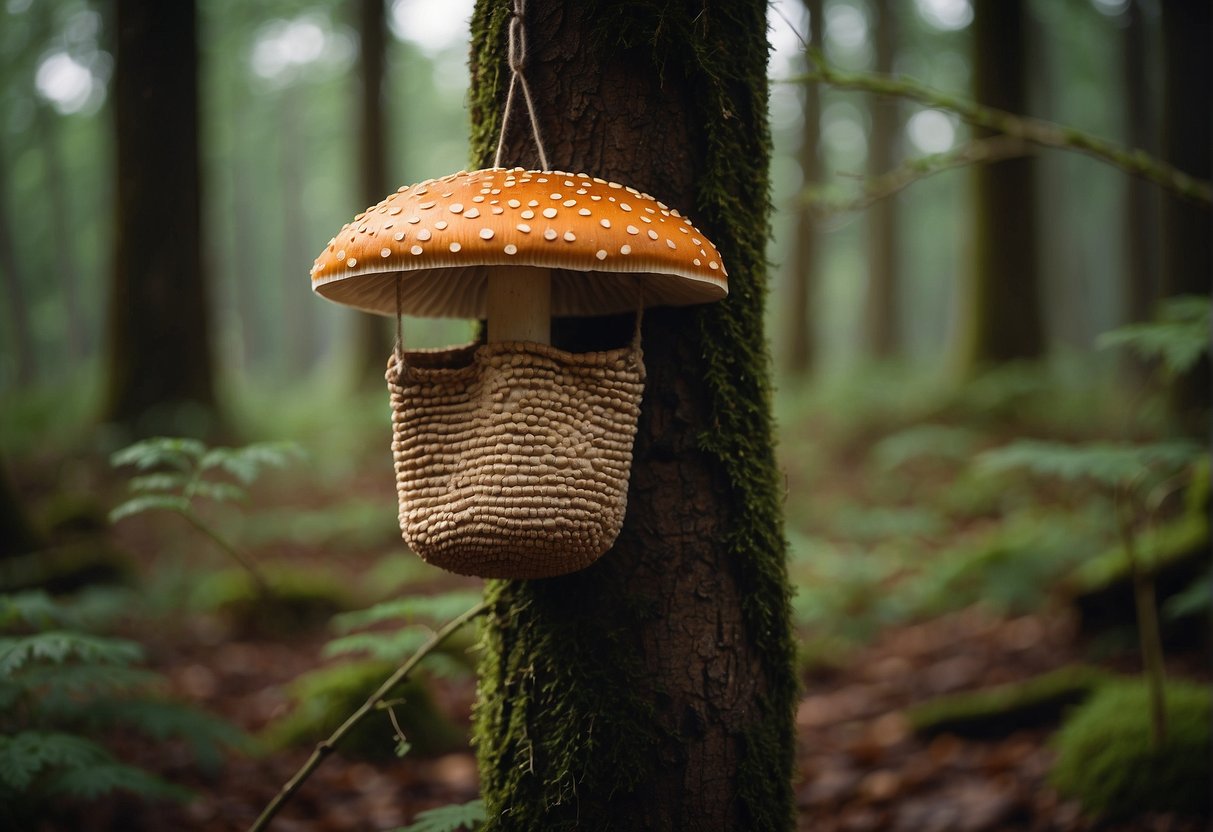
Your foraging bag isn’t just about function; it’s also part of the foraging tradition. A well-crafted bag is durable, has the right amount of space, and often features compartments for different types of mushrooms. Some bags are fitted with mesh bottoms allowing for spores to disperse back into the forest, promoting further fungal growth. This feature not only shows your respect for the ecosystem but also ensures that you leave behind a trail for future harvesting.
As you prepare for your next foraging adventure, remember that choosing a bag is like selecting a companion that will join you on every trip through the underbrush. It will carry the treasures you find and protect them until you can enjoy your harvest. Opt for a mushroom foraging bag that is comfortable to carry, suits your personal style, and upholds the ethical practices of foraging. With the right bag by your side, you’re ready to explore the forest’s bountiful offerings confidently and responsibly.
Essentials of Mushroom Foraging Bags
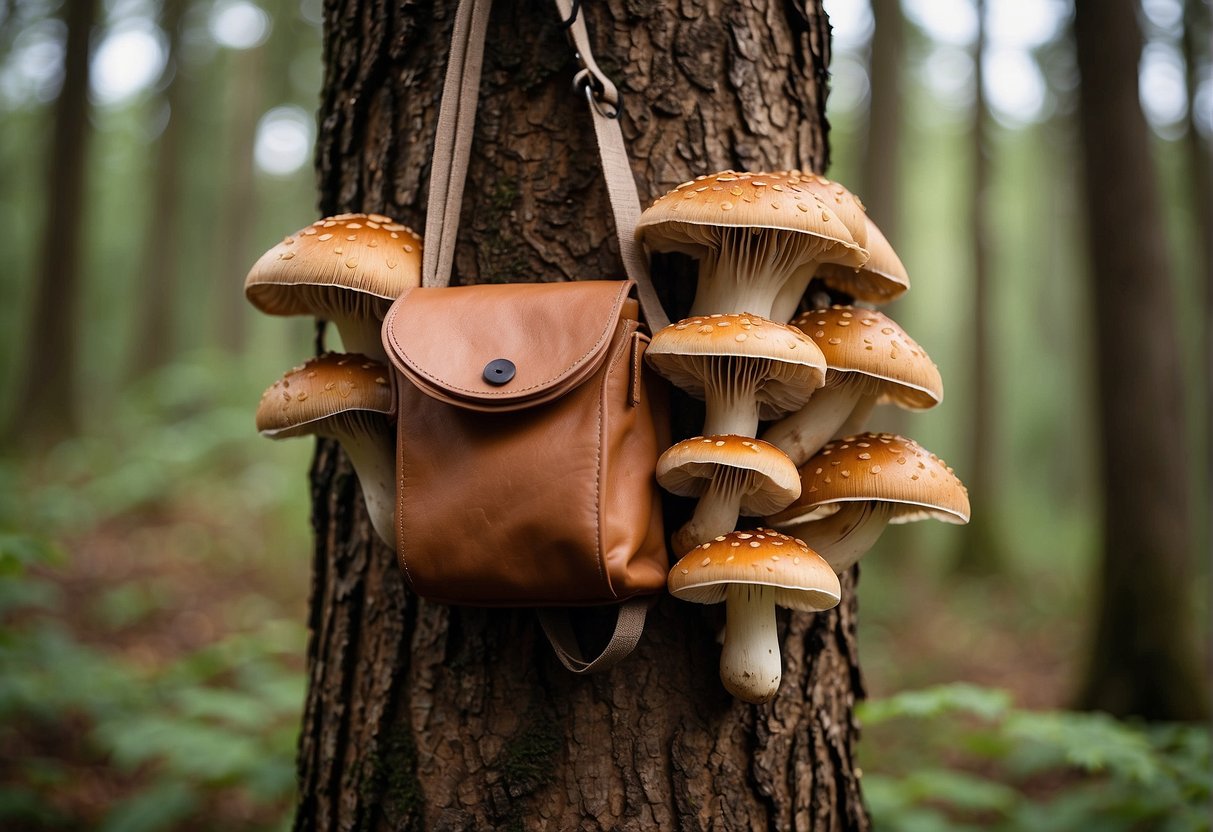
Selecting the right mushroom foraging bag is crucial to the success of your fungal treasure hunts. Your bag should combine functionality, convenience, and durability, ensuring that your foraging experience is as rewarding as it is enjoyable.
Design Considerations
Your mushroom foraging bag should be designed with the outdoors in mind. Look for a deep bag with multi-way straps that can be adjusted for your comfort, whether you’re trekking through dense woodland or strolling in an open field. The design should afford convenience while safeguarding the integrity of your fungi finds, a factor where a breathable mesh section plays a significant role, allowing for spore dispersal and preventing your mushrooms from sweating.
Material Selection
For your foraging bag, the choice of material is a balance between comfort and durability. Canvas is a time-tested option known for its robustness, while waxed canvas provides additional water-resistant benefits, great for damp conditions. Alternatively, a lightweight and breathable mesh bag can be beneficial for visibility and air circulation, minimising damage to delicate specimens.
Capacity and Compartments
The size and storage options of your bag are paramount. You’ll want a bag that’s spacious enough to hold a bounteous harvest without being cumbersome. Look for bags with multiple compartments, offering the ability to separate different species or store your foraging tools. This feature is essential to keeping your mushrooms in optimal condition during transport, avoiding the crushing or mixing that can happen in a single-compartment bag.
Selecting the Right Foraging Bag
When venturing into the woods to forage mushrooms or wild edibles, the right bag is key to protect your finds and promote their growth seasons to come.
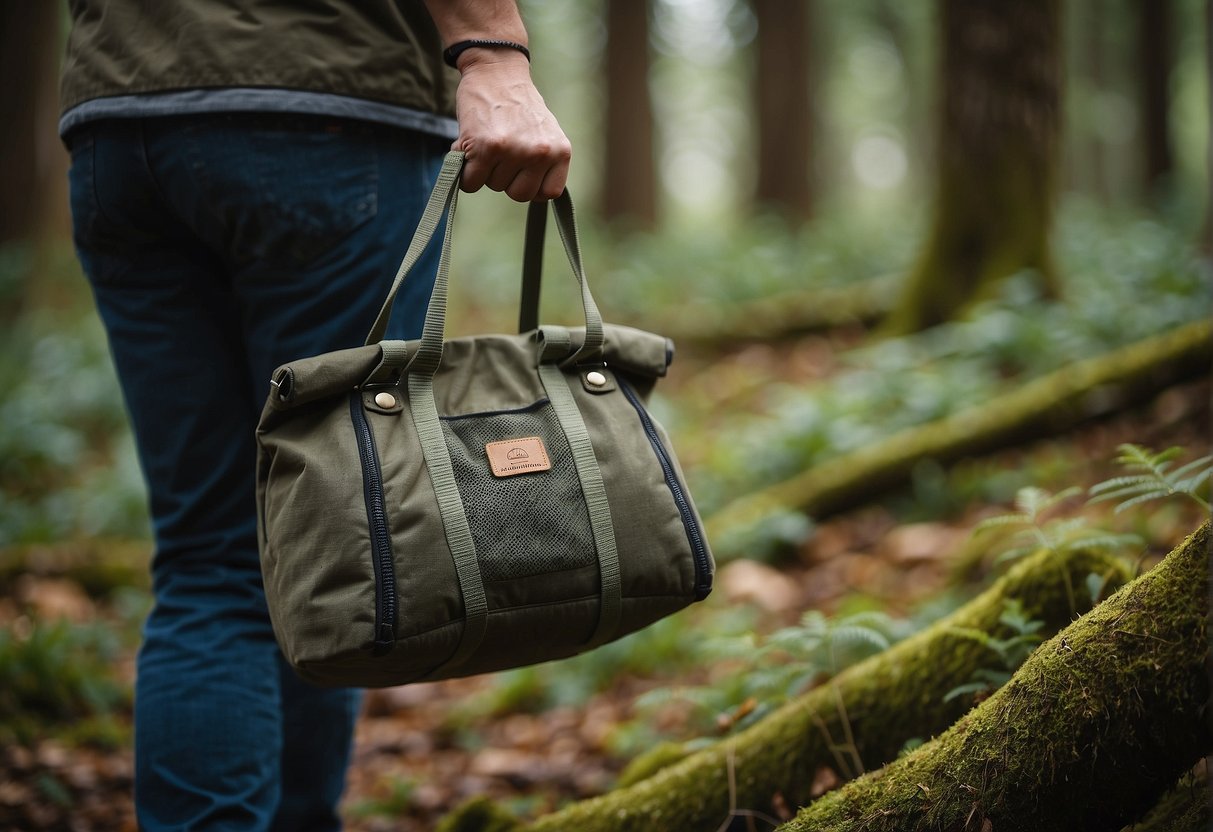
Types of Foraging Bags
There is a variety of bags suitable for foraging, and your choice profoundly impacts your experience. Canvas bags are durable and washable, a practical option for regular foragers. Wicker baskets have been the traditional choice for centuries, offering breathability that helps keep mushrooms and berries fresh. On e-commerce platforms like Etsy, you’ll also find handmade baskets which can add a personal touch to your foraging kit. For a comprehensive, ready-to-go option, foraging kits like the Vylersky Foraging Kit typically include a bag along with tools such as a mushroom knife.
Features to Look For
While searching for the perfect foraging bag, prioritize these features:
- Breathability: Essential for the longevity of mushrooms like morel mushrooms and chanterelles.
- Durability: Look for sturdy materials that can withstand the elements and the weight of vegetables, roots, and fruits you collect.
- Comfort: Adjustable straps or handles can save your shoulders and back during longer foraging excursions.
- Size and Capacity: Ensure the bag fits your typical haul of wild edibles, whether that’s a modest bunch or a hefty assortment.
Best Foraging Bag Practices
Your foraging bag isn’t just a container; it’s a tool that must be used correctly. Always:
- Avoid Overpacking: To prevent squishing delicate items like berries and mushrooms.
- Clean After Use: Especially important if using a bag made from fabric to remove any dirt and potential spores.
- Promote Spore Distribution: By using a bag that allows spores to escape, such as the Barebones Harvesting and Gathering Bag, you help propagate future growths.
Remember, foraging is not only about your immediate harvest but also about ensuring the sustainability of the environment you’re foraging in. Using the right bag will help keep the ecosystem healthy and productive for years to come.
Usage and Maintenance
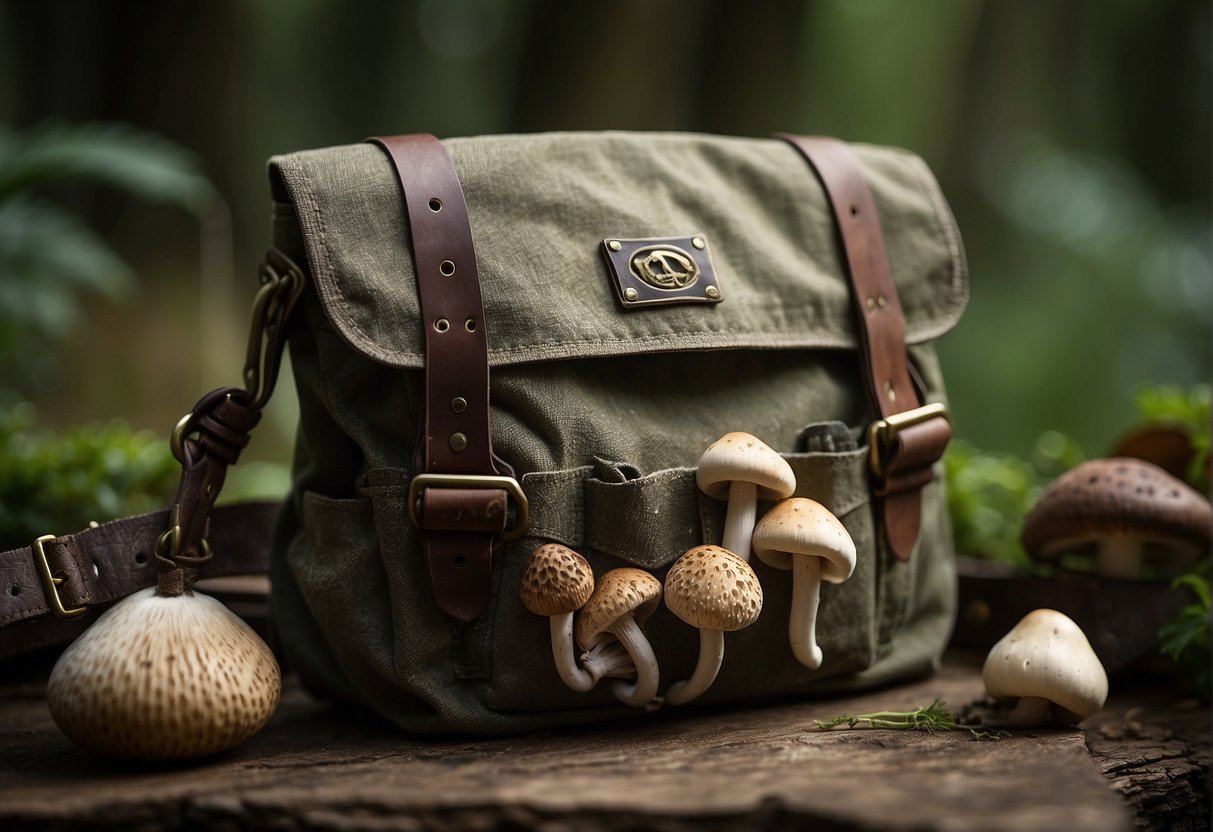
When it comes to maintaining your mushroom foraging bag, regular washing and timely repairs are crucial to its longevity. This piece of gear is a trusty companion in the wild and deserves your attention to detail.
Care Instructions
Washing: After each foraging trip, it’s important to empty your bag completely and shake out any loose dirt or debris. For most bags, a gentle hand wash using cold water and a mild detergent is best. If you have a canvas or cotton foraging bag, air-dry it away from direct sunlight to prevent shrinkage and fading. For bags with mesh components, make sure they’re fully dried to avoid mold and mildew.
Storage: Store your bag in a cool, dry place. If the bag is adjustable, make sure the straps are loosened before storage. This prevents the elastic or fabric from stretching out.
Durability and Repairs
Wear and Tear: Your foraging bag is designed for the rugged outdoors, but over time it may show signs of wear and tear. Regularly inspect your bag for any small rips or loose seams and address them before they become larger issues.
Damaged Parts: If parts of your bag become damaged, consider repairing them rather than disposing of the whole bag. Simple sewing repairs can often extend the life of a bag significantly. For adjustable straps or buckles, replacements are often available from the manufacturer or outdoor supply stores.
Remember, proper care and timely repairs of your foraging bag not only extend its life but also ensure the safety and quality of your harvested mushrooms.
Purchasing and Supporting Craftsmanship
When you’re looking to buy a mushroom foraging bag, it’s essential to consider both the quality of the craftsmanship and the impact of your purchase on local artisans and small businesses. A well-made bag can enhance your foraging experience, while supporting crafters contributes to sustainable shopping practices.
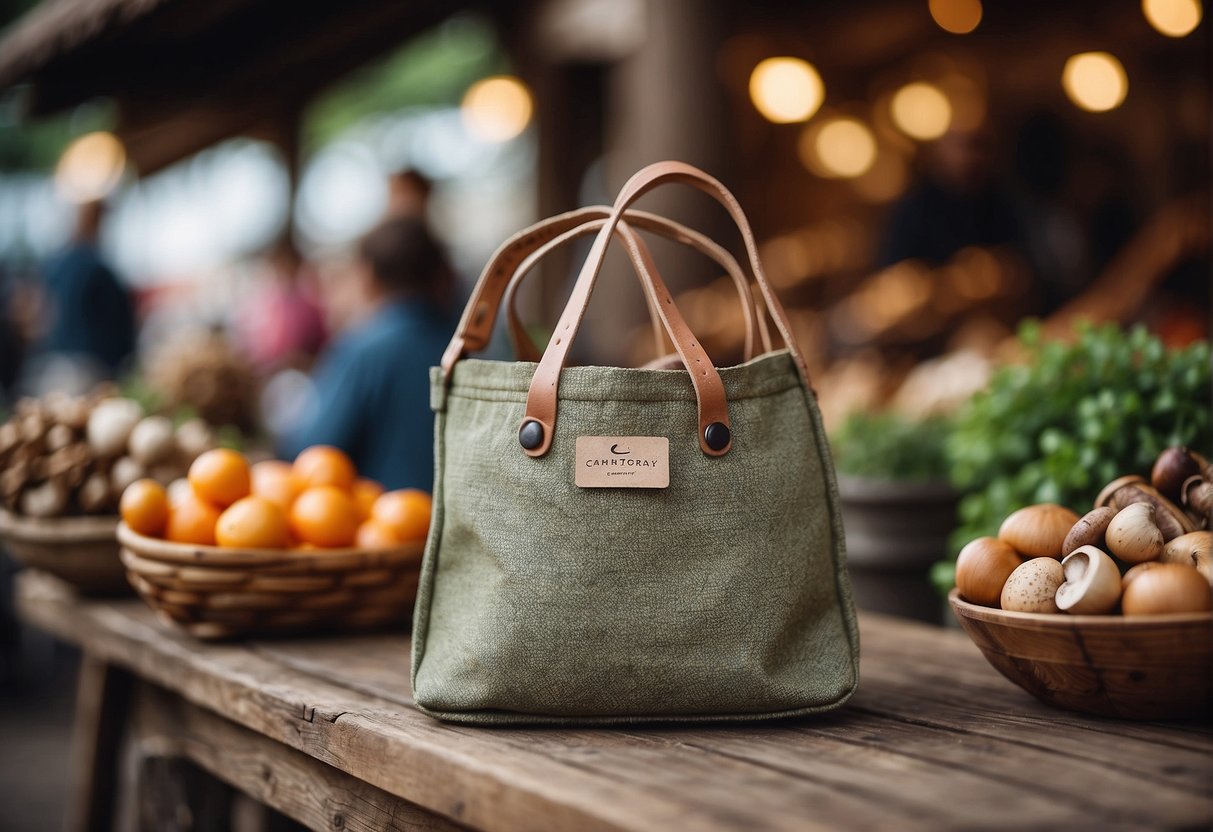
Where to Buy Foraging Bags
In your quest for the perfect foraging bag, you can explore a global marketplace online that offers an array of handmade pieces. Whether you’re looking for something vintage-inspired or a made-to-order item, websites like PNWBUSHCRAFT showcase a variety of options. While shopping, look for exclusive offers and check the shipping policies; many sellers offer perks such as free shipping. Also, subscribe to your favorite shop’s mailing list using your email address to stay informed about new collections and gift ideas.
Supporting Artisans and Small Businesses
By choosing to buy from small businesses, you’re often supporting individuals who put their passion for craft into each personalized product they make. Sites like MushroomPete.com not only sell foraging bags with practical features like snaps for easy access but also contribute to the community of outdoor enthusiasts. When purchasing craft supplies or a digital item such as a foraging guide, consider the artisans who use traditional techniques to create vintage treasures that offer both utility and a touch of nostalgia. Your support helps keep these skills alive and ensures that the market for handcrafted, personalized items remains robust.


